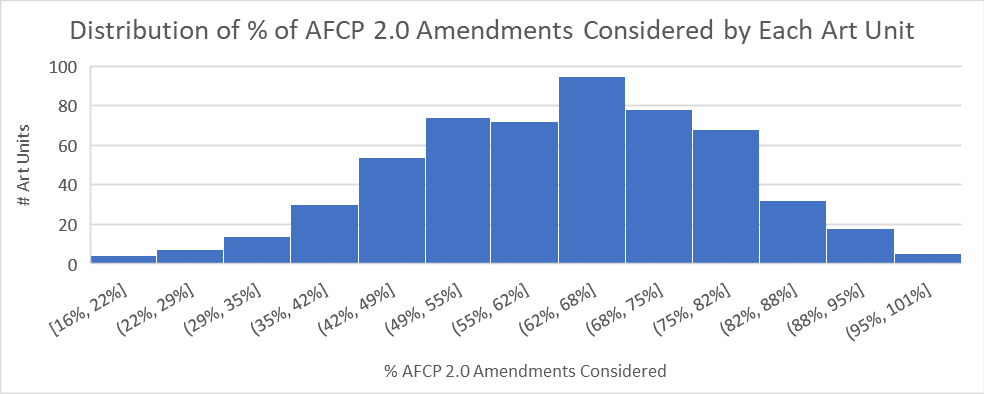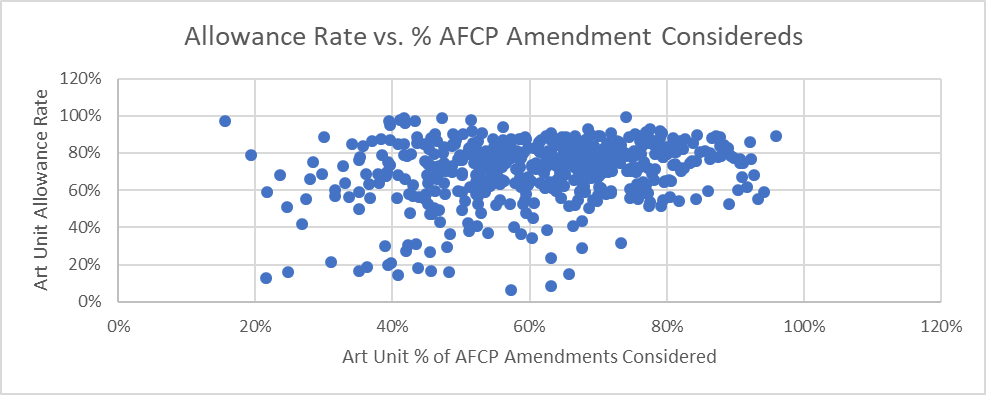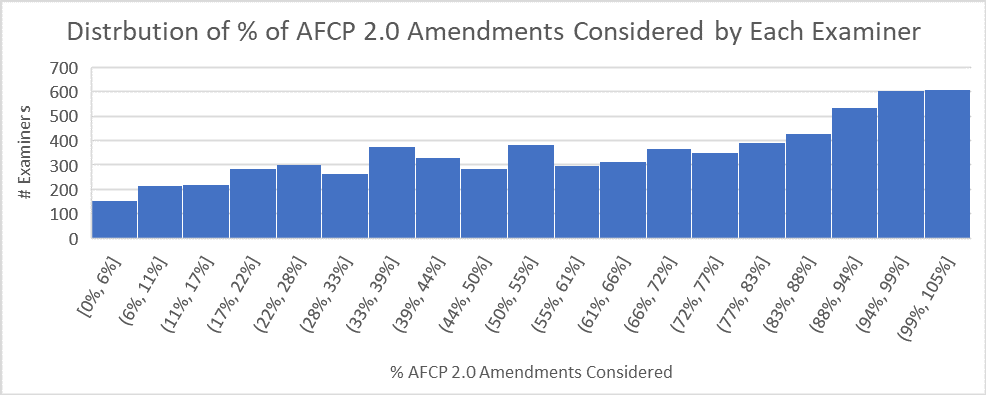As I touched on last week, for the ~80% of After Final Consideration Pilot 2.0 (AFCP) requests that are coded in PAIR, the amendments were considered in 61% of them, the amendments were deemed “too extensive” for consideration in 35% of them, and 4% were dismissed as improper requests. This raised the question of whether “difficult” examiners were more likely to consider amendments under the AFCP as “too extensive.” For purposes of this post, I am defining “difficult” as examiners who have a low allowance rate and/or who issue more actions per allowance.
After Final Consideration Pilot Requests by Art Unit
Here we see that the distribution of AFCP requests among art units is generally normal with a mean of 398 requests and standard deviation of 233 requests. (Aside: Of the 19 art units falling more than two standard deviations above the mean: TC 3700 accounts for 13 of them and TC 2800 accounts for the other 6)
Percent of AFCP Amendments Considered by Art Unit
This distribution is also generally normal with a mean of 62% and standard deviation of 15%. The tables below show the outliers.
Art Units Which Consider a Very Low Percentage of AFCP Amendments
| ArtUnit | AFCP 2.0 Requests | % Amendments Considered |
|---|---|---|
| 3795 | 173 | 16% |
| 2811 | 392 | 19% |
| 3681 | 316 | 22% |
| 1779 | 262 | 22% |
| 2854 | 478 | 24% |
| 1712 | 523 | 25% |
| 3683 | 487 | 25% |
| 1792 | 409 | 27% |
| 2427 | 139 | 27% |
| 2447 | 407 | 28% |
| 2871 | 997 | 28% |
| 2157 | 310 | 30% |
| 2825 | 223 | 30% |
| 3688 | 386 | 31% |
| 1782 | 475 | 32% |
| 1714 | 483 | 32% |
Art Units Which Consider a Very High Percentage of AFCP Amendments
| ArtUnit | AFCP 2.0 Requests | % Amendments Considered |
|---|---|---|
| 2172 | 406 | 92% |
| 2867 | 253 | 92% |
| 2693 | 352 | 92% |
| 1676 | 110 | 93% |
| 2128 | 407 | 93% |
| 2122 | 272 | 94% |
| 2497 | 411 | 96% |
Weak Correlation Between Consideration of AFCP Amendments and Art Unit Allowance Rate
Each dot on the above chart represents an Art Unit. As art unit allowance rate goes up, so too does the percentage of AFCP amendments that the art unit considers. The correlation coefficient is 0.24 which would generally be considered a weak correlation. In other words, plenty of art units with low allowance rates consider a high percentage of AFCP amendments, and plenty of art units with high allowance rates consider a low percentage of AFCP amendments.
Weak Correlation Between Consideration of AFCP Amendments and Art Unit Actions Per Allowance
Each dot on the above chart represents an Art Unit. As average number of actions per allowance goes up, the percentage of AFCP amendments that the art unit considers goes down. The correlation coefficient is -0.3 which would generally be considered a weak negative correlation. So plenty of art units average a lot of actions per allowance despite considering a large percentage of AFCP Amendments, and plenty of art units average a relatively low number of actions per allowance despite considering only a small percentage of AFCP amendments.
Even Weaker Correlations for Individual Examiners
I also looked at the same two metrics for individual examiners (as opposed to art units). I didn’t bother graphing the correlations were even weaker: a correlation coefficient of 0.18 for allowance rate and percentage of AFCP amendments considered; a correlation coefficient of -0.19 for actions per allowance and percentage of AFCP amendments considered.
With AFCP, Your Mileage May Vary Depending on Your Examiner
Here’s the distribution of the percentage of AFCP amendments considered by each examiner (minimum of 10 AFCP requests):
I’m not sure what to make of this distribution, but it sure seems odd. And I am guessing it reflect highly subjective interpretations of what constitutes an amendment that is “too extensive.”
As just one anecdote: there are 11 examiner that received over 100 after final consideration pilot requests in the past 3 years. At one end of those 11 examiners is Amina Khan who has considered 101 of 102 AFCP Amendments. At the other end is Alejandro Valencia who has considered none(!) of 102 AFCP requests. And yet both appear to be very “tough” examiners by a variety of measures.






